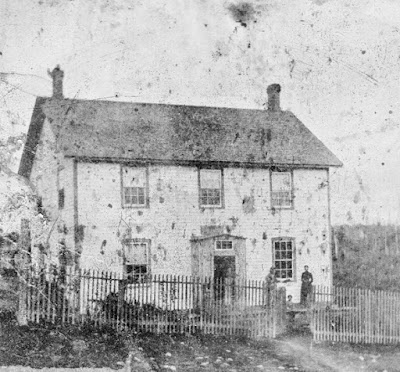From an applique quilt in the collection of
the New England Quilt Museum.
In the last post
I mentioned the yellow house seen in several New York samplers.
Common vernacular house style before the Civil War.
It could be a generic yellow house but it's not.
It is a specific house.
It has the gables on the ends, which defines it loosely as Greek Revival or Federal style.
Two chimneys.
Three bays with windows above.
A distinctive central door.
The house is surrounded by trees of various kinds.
And sometimes has a gated fence in front.
When viewed from the side the gable end has a third-story arched window.
Sometimes it has a one story addition as in this
example dated 1847-1849, made by Mary Catherine Dearborn (1832-1917)
of Westchester County, New York.
Mary married Ammi K. Close. Her quilt, made when she was in her mid-teens, was documented in the New York Quilt Project and is in their book New York Beauties on page 68. The family had a few details wrong. She lived in Ketonah and North Salem and she may have been born in 1833 and died in 1907.
Mary Dearborn Close's quilt
Could this recurring yellow building be a school, perhaps a school in Westchester County, New York, where a needlework teacher encouraged her students to finish off their quilts with double scalloped edges?
The North Salem Academy in Westchester County served boys and girls
from 1790 to 1884. The building has a gambrel roof (like a barn) and five bays----
it's not the yellow house.
The idea of depicting a building, often a school, is quite common in embroidered samplers in England and the U.S. before the 1850s.
Fanny Keever's 1833 sampler
from Stephen & Carol Huber.
Fanny worked her sampler at a school in Hummelstown, Pennsylvania.
C. Jontz instructor.
Sampler by Hannah Kelter Dec 17th 1835.
According to dealers Stephen & Carol Huber: "Hannah wrought this sampler at Misses Robinsons' school in Montgomery County, Pennsylvania. The Misses Robinsons' school was run by four unmarried sisters in their family home."
http://www.antiquesamplers.com/samplers/kelter.htm
Hannah Robinson's 1819 combination embroidery and watercolor.
Collection of the Metropolitan Museum of Art.
Sampler historians often categorize samplers by school. The Robinson sisters' needlework school was in Upper Providence, Pennsylvania. Colonial Williamsburg counts eight samplers from the Robinson school.
The National Society of Colonial Dames has a register of teachers and schools for research into needlework but I didn't see any likely places for a yellow house in Westchester County.













It reminds me of the Elijah Cobb mansion, Cape Cod MA. It used to be yellow :https://capecodlife.com/a-house-with-history/
ReplyDeleteI see those designs all the time but never really noticed how similar the houses are in the samplers and quilts, very fun and interesting read.
ReplyDeleteDebbie
This comment has been removed by the author.
ReplyDeleteSorry, never took typing in school and the result was quite apparent in my last post!
ReplyDeleteAnyway, I commented on the vibrant colors. I really like the quilts as my eyes are moved about in a nice way. I find my muted color preference from the past is changing.
Robert---you and me too. It is amazing how fashion compels a change in preferences.
ReplyDelete